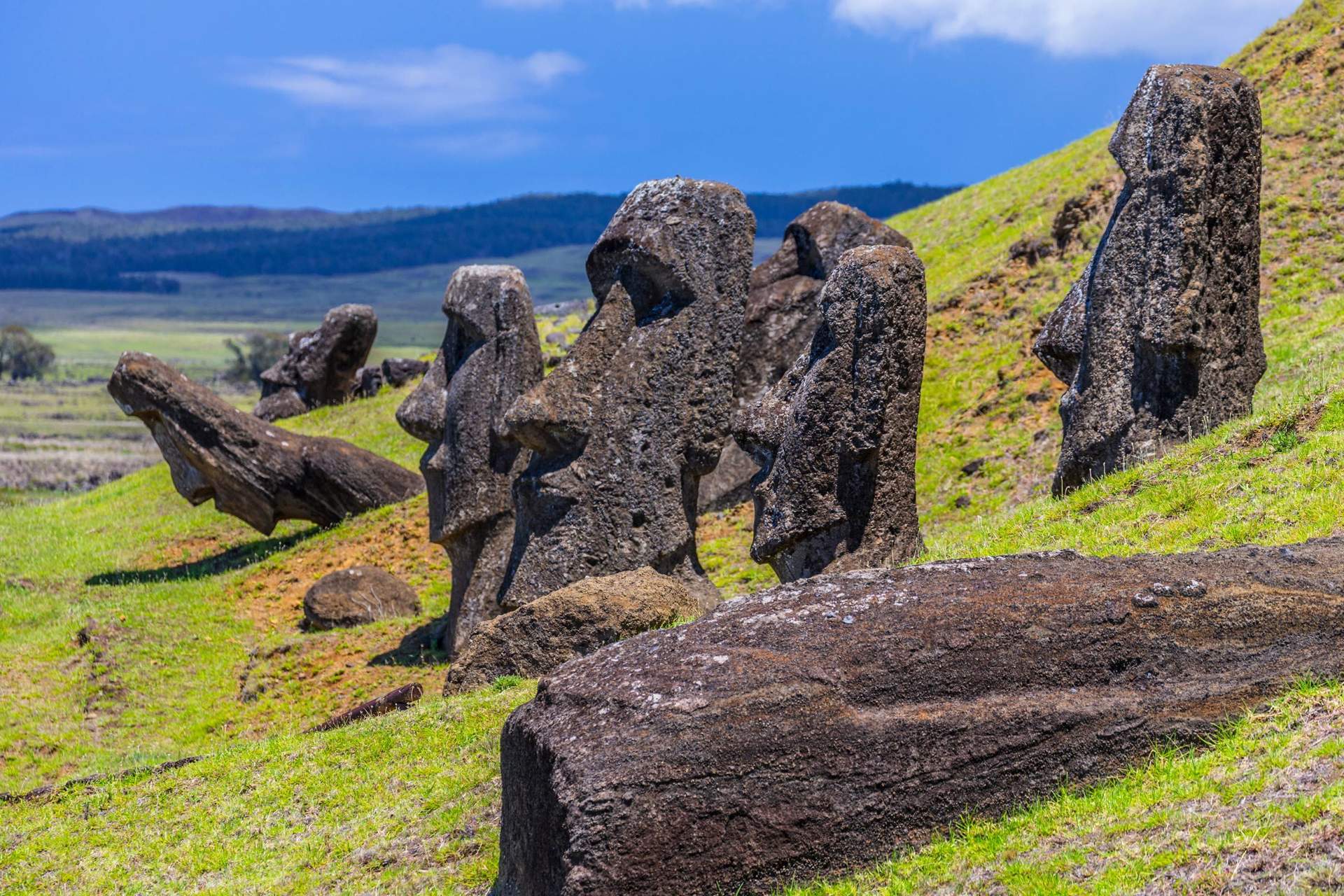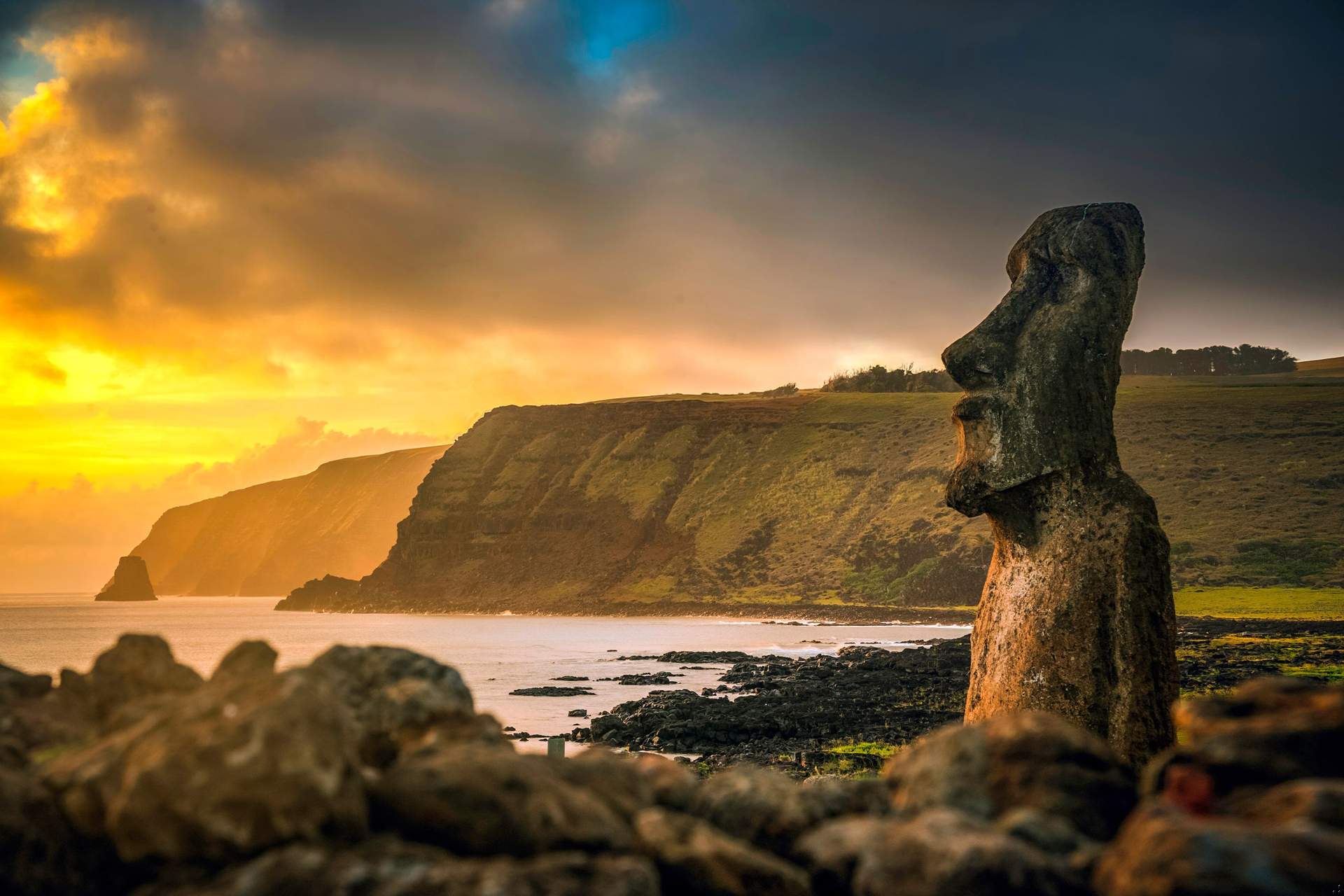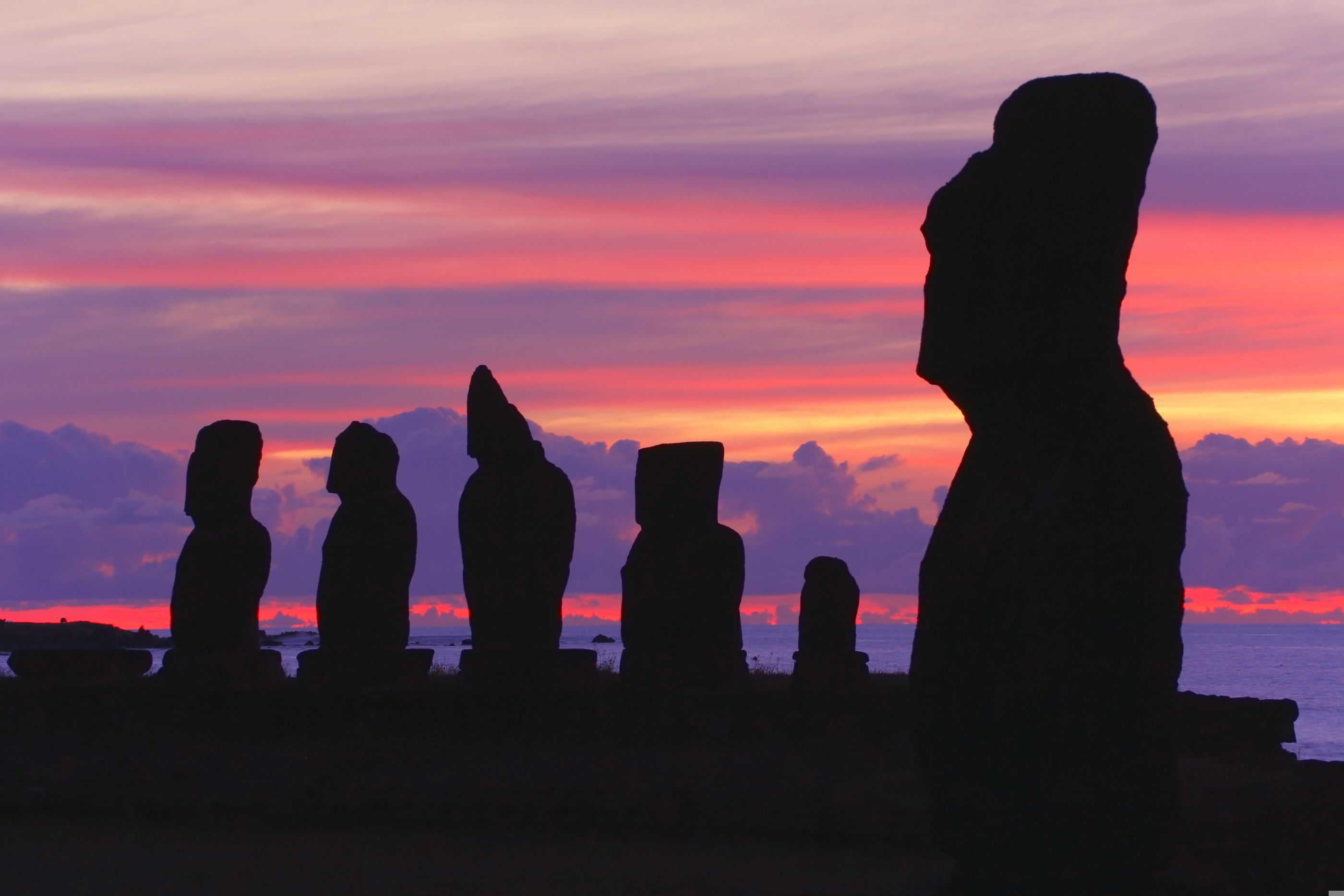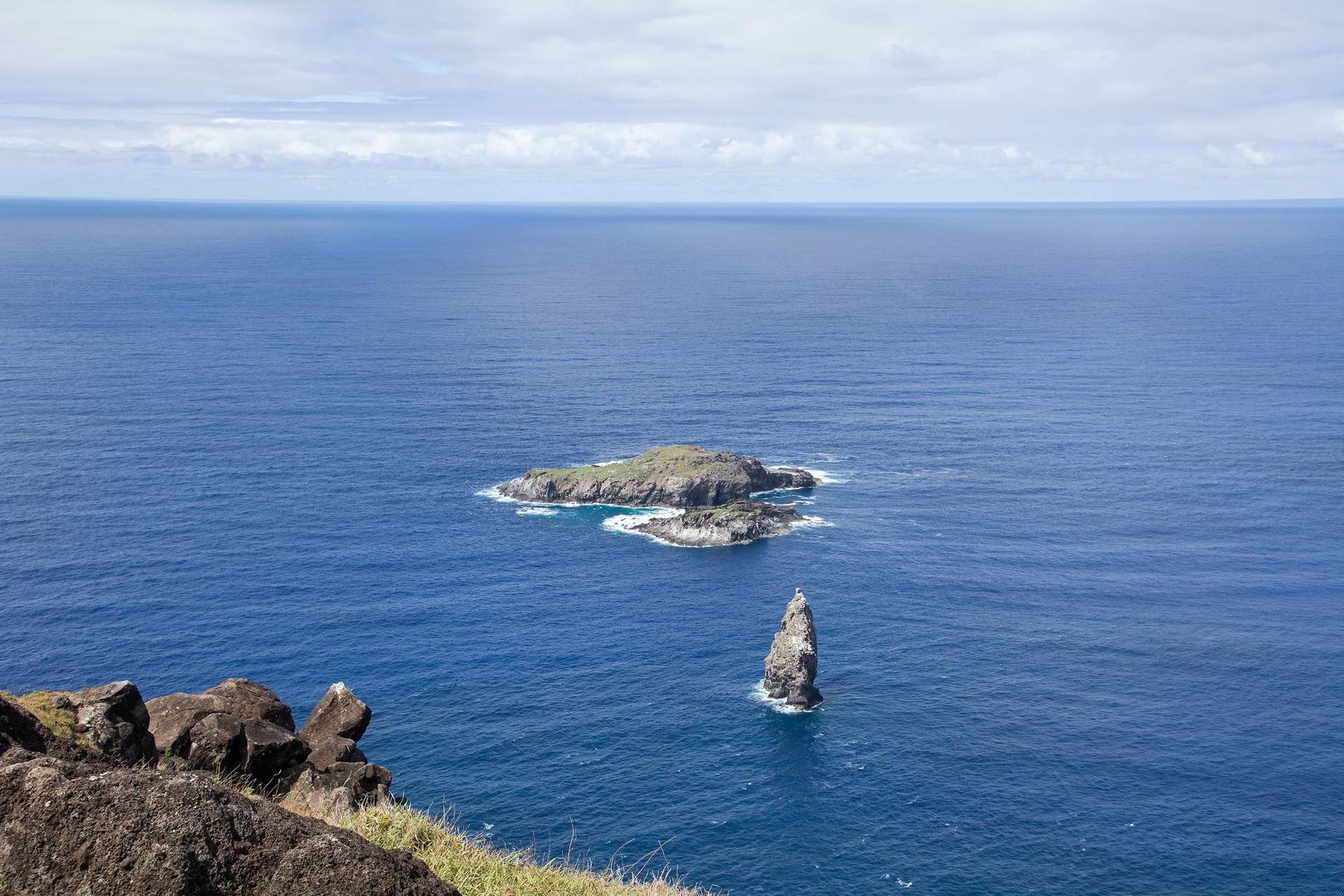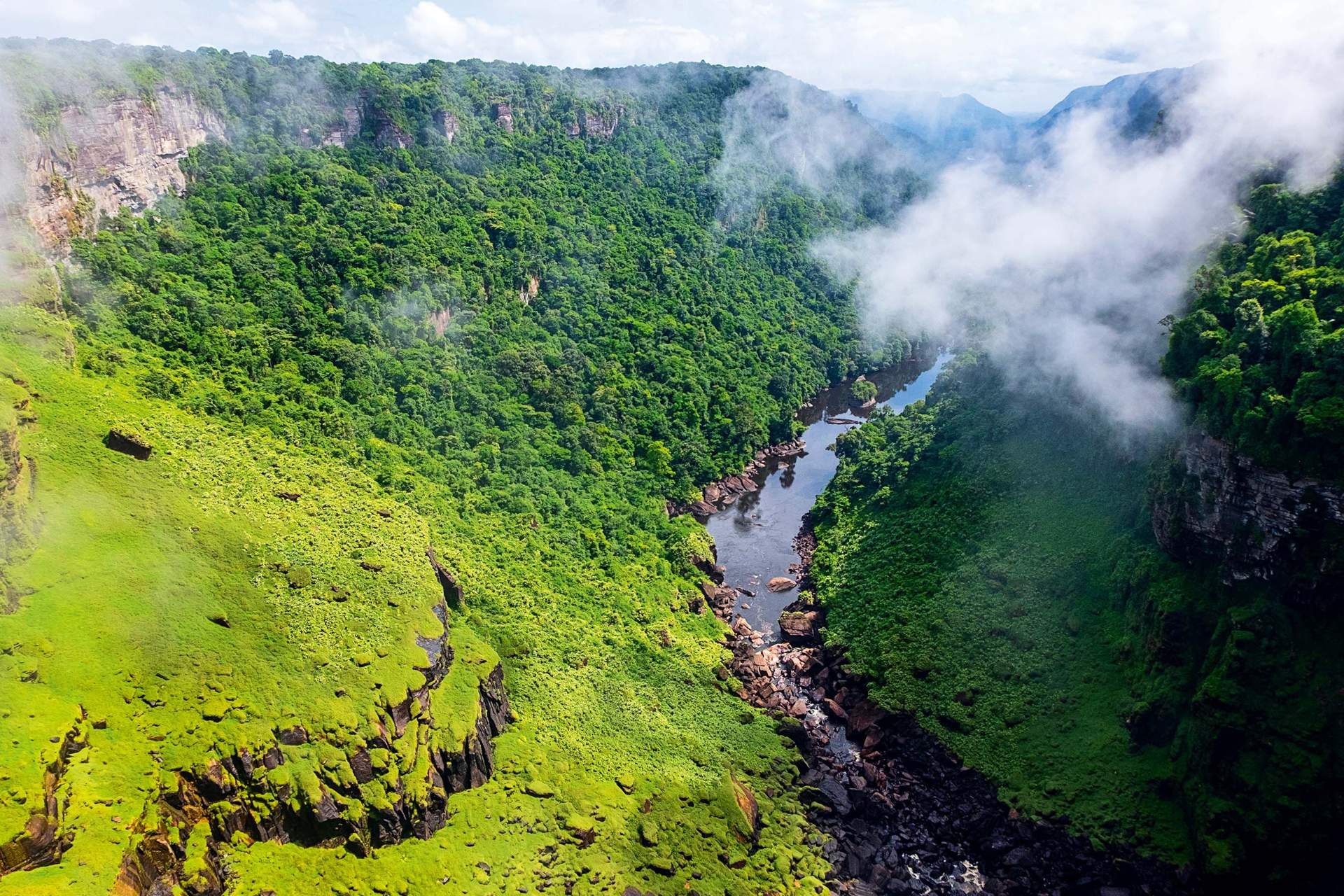The new podcast from Wanderlust is available to stream now!
Want to hear Easter Island brought to life?
In the third episode of the first series of Wanderlust: Off the Page we speak to award-winning travel writer Shafik Meghjito uncover the enchanting and remote Easter Island, learning about Shafik’s first hand experiences and diving into the destination’s remarkable history, culture and nature.
After a steep hike up the Te Ara O Te Ao trail, through eucalyptus, papaya, cypress and acacia trees, and across swaying grasslands dotted with purple-flowering thistles, I finally reached the vast crater rim of Rano Kau, a 324m-high volcano that dominates the southernmost tip of Easter Island. The calls of a swooping, hawk-like caracara briefly sounded before being drowned out by a howling wind that threatened to buffet me over the precipice and into the flooded caldera below.
Now dormant, Rano Kau is home to the ruins of a ceremonial village named Orongo, which is closely associated with the fabled Birdman contest. To the north, it offers views of the island’s only town, quiet, low-rise Hanga Roa – with the aid of my camera zoom, I even made out a pair of moai statues on a distant headland. In the opposite direction the navy-blue waters of the Pacific were perfectly framed by a shallow, semi-circular gap in the crater wall. Although it’s one of Easter Island’s most dramatic sites, Rano Kau is rarely crowded. There was no one else at the crater or on the narrow path to Orongo. Indeed, when I gazed out at the seemingly endless ocean the thought struck me that, beyond the island’s shoreline, there was no one within 2,000km.
The naval of the world
Rano Kau, Easter Island (Shutterstock)
Known locally by its Polynesian name Rapa Nui, Easter Island (Isla de Pascua in Spanish) is one of the remotest inhabited islands on earth. Less than half the size of the Isle of Wight, it is stranded in the Pacific Ocean, more than 3,500km west of mainland Chile. The island’s nearest inhabited neighbour, Pitcairn, lies just over 2,000km to the west – roughly the distance between London and St Petersburg. It is this mind-boggling isolation that keeps drawing me back: a desire to experience life on a tiny, triangular speck of land so far removed from anywhere else.
Easter Island’s remarkable culture and history provide a similarly magnetic pull. It was settled between AD 800 and 1200 by intrepid Polynesian navigators – probably from the Marquesas or Gambier archipelagos – who sailed for thousands of miles across the uncharted ocean in double-hulled voyaging canoes. Once they arrived they embarked on a frenzied period of statue carving – a form of ancestor worship – almost without parallel. My guidebook work has taken me to an island often referred to as Te Pito O Te Henua – the Navel of the World – three times over the past decade.
On the most recent occasion, before the pandemic, my five-hour flight from Santiago landed in the late evening. Within 20 minutes I’d collected my backpack, received a lei of pink and white flowers, and been transferred to the Nayara Hangaroa hotel. I had three full days to explore and was keen to combine the more famous attractions – places I’d seen before but that generously repay repeat visits – with others that are lesser known.
Sunrise to sunset
Sunrise over moai (Shutterstock)
The following morning I was up before dawn for a 30-minute drive to the coastal site of Ahu Tongariki. It was still gloomy when I arrived and the 15 monumental moai – the largest weighing around 30 tonnes – loomed imperiously out of the shadows on top of a 220m-long platform or ahu. In the background, the sun rose steadily out of the Pacific, illuminating the biggest surviving ceremonial structure in Polynesia with a burnt-orange spotlight. The statues represent revered ancestors and face inland, watching over the Rapanui and providing protection when needed. Sometimes, however, they require a little help of their own. In 1960 a tsunami struck the island, knocking the Ahu Tongariki moai off their perch; they were only restored in 1995, thanks to financial assistance from Japan.
A 10-minute walk inland took me to Rano Raraku, a grass-covered crater where most of the 1,000-or-so statues on Easter Island were carved in situ from lapilli tuff, a rock of compacted volcanic ash; they were then transported – probably on wooden sledges or rollers, although legend says they walked using their mana or spiritual energy – to platforms across the island. However they moved, it was a monumental feat. Almost 400 unfinished, broken and abandoned moai remain in the quarry, their gigantic heads and torsos protruding from the slopes at erratic angles, as if sprouting from the soil itself. They include Te Tokanga, the Giant, the largest moai ever carved. He reclines on his back, almost 22m tall and weighing around 200 tonnes, equivalent to 30 African elephants. Rano Raraku is a mesmerising but vaguely melancholic place; it felt as if the master carvers had fled in a hurry, leaving their inscrutable subjects in the lurch.
Later I headed over to Anakena, where a crescent of golden sand, sprinkled with palm trees and moai, meets the turquoise sea – an excellent spot for a swim. It is a beach upon which I would gladly be cast away. But it also has a deep cultural resonance: according to oral traditions, it was where the first settlers landed a millennia or so ago, creating the easternmost outpost of Polynesian culture.
Back in Hanga Roa I bought a bottle of locally brewed Mahina beer and an empanada stuffed with tuna and joined the crowds at the ceremonial site of Tahai. Beyond a pretty, flower-filled cemetery, a grassy slope provided a viewing platform for a series of squat moai, the sun slowly melting into the Pacific behind them.
The lost script of rongorongo
Tahai Ceremonial Complex at sunset (Shutterstock)
I wanted to spend my second day exploring some sites I’d missed on earlier trips, so took a tour with Hana, a cheerful guide from the hotel. She drove us inland to the gentle volcanic hill of Puna Pau, site of a quarry that provided the iron-rich scoria rock used to carve the pukao (topknots) added to many of the later moai. They represented Rapanui hairstyles at the time, Hana explained. We continued on towards Maunga Terevaka, the highest peak on the island, before stopping at the deserted site of Ahu Akivi. Some believe the virtually identical moai here represent the seven explorers who, according to legend, first discovered Easter Island. The most impressive aspect of the site, said Hana, was that the central moai is precisely oriented so that he faces the sunset during the spring equinox and has his back to the sunrise during the autumn equinox.
We drove on, scattering groups of the semi-feral horses that roam the island, until we reached Ana Te Pahu, one of several lava tubes, some of which stretch for kilometres. As we clambered down into a cavernous, subterranean world, Hana told me that these natural formations were once used for shelter, to collect rainwater – vital on an island desperately short of fresh water – and, thanks to their favourable microclimate, to grow crops such as bananas, pineapples and taro.
Ana Te Pahu was also used as a hiding place, notably during the conflicts – probably driven by increasing scarcity of food and other resources – that eventually led to the toppling of the moai in the late 18th and early 19th centuries. Contact with the wider world, starting when Dutch navigator Jacob Roggeveen spotted the island on Easter Sunday 1722, also had a major impact. Within 150 years, slaving raids from Peru and diseases such as smallpox had decimated the indigenous Rapanui population. Christian missionaries and exploitative ranchers arrived later, before Chilean annexation in 1888 and the onset of colonialism. It took until 1966 for the Rapanui to gain full Chilean citizenship and the right to vote. Local autonomy, including over the national park, which covers most of the island, and the surrounding marine reserve – one of the largest in the world – has increased in recent years.
“The island’s current population is roughly half of what it was at its height,” said Hana on the drive back to Hanga Roa, explaining that an 1877 census recorded just 111 Rapanui islanders. Today, almost half of the 7,750 population are Rapanui, who speak a Polynesian-based language as well as Spanish. Beyond a few foreign residents, the rest are from mainland Chile. “Now, many of us [Rapanui] are related, which makes it difficult to find a husband,” she joked, with a wry smile.
Hana’s tour sharpened my desire to learn more about the island’s culture, so I headed to the Museo Rapa Nui, a small but rewarding museum where an afternoon drifted by in a flash. There was a rare female moai, some of the few surviving moai eyes – ruby-red scoria pupils in circles of white coral – and a range of obsidian tools. But the item that really captured my imagination was a replica rongorongo tablet, a wooden board roughly the size and shape of a cricket bat minus the handle and covered with beautiful geometric glyphs. Some academics believe rongorongo is one of only a handful of written languages to have developed independently. Frustratingly, knowledge of the script died out in the 19th century and it remains undeciphered.
The Birdman trail
A local man in native dress, Easter Island (Shutterstock)
On my last morning, I strolled to the outskirts of Hanga Roa, along empty streets lined with wooden bungalows and luxuriant gardens, to meet James Grant-Peterkin, the most remote British Honorary Consul in the world – a title that sounds like it has slipped from the pages of a Graham Greene novel. Also a guide, author of A Companion to Easter Island and one of only a handful of foreigners to speak the Rapanui language, James looked more like a surfer than a state representative, dressed in board shorts and sporting an arm tattoo. Over coffee I asked him about an aspect of the island’s history that is often overshadowed by its statues: the Birdman contest.
The conflicts that resulted in the toppling of the moai, James explained, prompted the warring factions to collectively develop a new set of religious beliefs to help restore order. “They came up with a competition in the spring, coinciding with the seabirds, particularly the sooty terns, that nested here every September,” he said. “Each tribe put forward a young man who competed to get the first sooty tern egg of the year [from the offshore islet of Motu Nui]. The winner transferred power to his chief, who was named Tangata Manu – Birdman – and became the spiritual leader of the island for the next 12 months.” The competition lasted for some 150 years until missionaries put an end to it in the 1860s.
The chat confirmed my plans for my final afternoon: a hike up the Te Ara O Te Ao trail to Rano Kau and the ruins of Orongo, a route once walked by Birdman contestants. Precariously perched on a 300-metre-high clifftop, Orongo is scattered with the remains of low, oval-shaped ceremonial buildings and exquisite petroglyphs slowly succumbing to the elements. (It was also once the home of Hoa Hakananai’a, a moai decorated with Birdman imagery, which is now in the British Museum; many islanders are calling for his return.) After looking around the site, I walked towards the edge and peered down at the near-vertical drop, the waves lashing the shore and at the seemingly impenetrable sides of Motu Nui in the near distance, marvelling at the athleticism, courage and bloodymindedness of the Birdman competitors, who would swim back from the islet and scale Rano Kau’s sheer cliffs.
Orongo was another reminder that Easter Island offers much more than moai. My trip had given me a broader perspective, taking me to places I’d missed or hurried through in the past, illuminating aspects of the island and its heritage I’d previously overlooked, and refreshing memories of more familiar sites. It left me better informed – and already plotting a return in the future.
I walked back through the Orongo visitor centre, where there were stark warnings that the site was at risk due to erosion. This is one of several challenges facing Easter Island, alongside inadequate services and facilities, the impact of migration from mainland Chile, overtourism (more than 100,000 people visited annually before the pandemic) and, of course, the climate crisis.
But after learning more about the history, culture and resilience of the Rapanui people, I departed for Santiago feeling optimistic. After all, for the descendants of pioneering seafarers, master carvers and islanders who overcame existential threats for centuries, nothing seems insurmountable.
Footnotes
The Trip The author stayed at the Nayara Hangaroa hotel, which provided accommodation and a guided tour.
Getting thereBritish Airways flies direct from London Heathrow to Santiago. Flight time is roughly 14.5 hours. It my be cheaper to travel via a European, USA or Latin American city with an airline such as LATAM or Iberia. LATAM is the only airline serving Easter Island, flying daily to/from Santiago. Flight time is from 4.5 hours.
Getting around Guided group tours of the main sites are popular but often a bit hurried. Kava Kava Tours and Easter Island Spirit, run by James Grant-Peterkin, offer private tours. There’s no public transport and few taxis but several places rent out cars and motorbikes; note that there’s no vehicle insurance on the island. Hiring a bike is a good option for visiting local sites.
Accommodation Almost all of Easter Island’s hotels and guesthouses are in or around Hanga Roa. Prices are high and the most popular places often get booked up quickly. There are several decent mid-range options with double rooms such as Hostal Tojika, plus a few cheaper hostels and campsites. The luxurious Nayara Hangaroais at the top end of the scale.
More on Easter Island





























